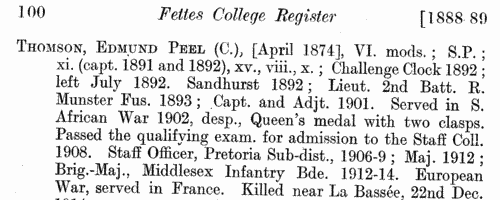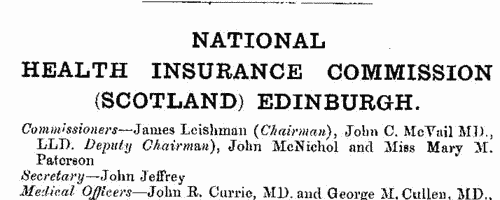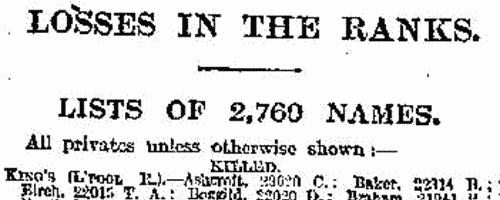Add this eBook to your basket to receive access to all 889 records. Our indexes include entries for the spelling small. In the period you have requested, we have the following 889 records (displaying 751 to 760): These sample scans are from the original record. You will get scans of the full pages or articles where the surname you searched for has been found. Your web browser may prevent the sample windows from opening; in this case please change your browser settings to allow pop-up windows from this site.  London Metropolitan Police
(1902-1911) London Metropolitan Police
(1902-1911)
The London Metropolitan Police Register of Joiners (MEPO 4/337) lists policemen joining the force 14 July 1902 to 10 April 1911 (warrant numbers 88812 to 100006). The register is alphabetical, in so far as the recruits are listed chronologically grouped under first letters of surname. It gives Date of Appointment, Name, Number of Warrant, Cause of Removal from Force (resigned, dismissed, promoted or died), and Date of Removal. The information about removal is sometimes wanting. A final column of 'Remarks' is largely blank, but occasionally gives an alias or a cross-reference to another warrant number. The register is discoloured and damaged in places, and one or two pages are missing. | Sample scan, click to enlarge

| Boys entering Fettes College, Edinburgh
(1913)
Fettes College, Edinburgh, was opened in 1870 under the terms of a trust 'for maintenance, education, and outfit of young people whose parents have either died without leaving sufficient funds for that purpose, or who, from innocent misfortune during their own lives, are unable to give suitable education to their children'. In 1923 this edition of the Fettes College Register was published; in it the compilers sought to set out for each boy who had attended the college a brief synopsis of what was known about his time at the school, his subsequent career, and date and place of death, or address as of 1923. Of course, for most of the boys entering the school in the early 20th century, their career was still ahead of them. After each name there is a letter in brackets indicating the house to which the pupil belonged - (C.) Carrington House; (G.) Glencorse House; (K.) Kimmerghame House; (M.) Moredun House; (S.) Schoolhouse. An asterisk indicates that the boy was a foundationer, i. e. supported by the foundation; a dagger that he was a foundation scholar. VIA. indicates Upper Form; Mods. Modern School; Army Cl., Army Class; S. P., School Prefect; xx. First Rugby Football Twenty; xv. First Rugby Football Fifteen; xx. cap. Caps occasionally given to the five (or fewer) next to the First Fifteen after 1875; xi. First Cricket Eleven; viii. Gymnastic Eight; Trs. Prizes and Exhib., Trustees' Prizes and Exhibitions; Govs. Prizes and Exhib., Governors' Prizes and Exhibitions; Schol., scholarship; M., married. Month and year of birth is given in square brackets. | Sample scan, click to enlarge

| Civil Servants and Office Holders
(1913)
The Imperial Calendar gives lists of officials and office-holders throughout England, Wales, Scotland and Ireland
| Sample scan, click to enlarge

| Naval Ratings Killed in 1914
(1914)
The monthly lists of Royal Navy ratings killed from the start of the Great War through to the end of December 1914 are aranged alphabetically by surname and christian names, with rank, and official number. The lists include marines, reservists, and a few civilian canteen staff also killed in the conflict. Full names are given, except for a few cases where a middle name is represented only by an initial.
| Sample scan, click to enlarge

| Naval Ratings Killed in 1915
(1915)
The monthly lists of Royal Navy ratings killed from the start of the Great War from January to December 1915 are arranged alphabetically by surname and christian names, with rank, and official number. The lists include marines, merchant navy, reservists, and a few civilian canteen staff also killed in the conflict. Full names are given, except for a few cases where a middle name is represented only by an initial.
| Sample scan, click to enlarge

| Soldiers killed: South Lancashire Regiment
(1916)
Lists of names of soldiers wounded, died of wounds, died, missing presumed dead, and taken prisoner by the enemy, were issued to the British national press under the title Roll of Honour. Each man is identified by surname, initials and number. The regimental returns from which the daily Roll was compiled were made up over the previous week or weeks. Each regimental return may be partial, covering only part of the alphabet. The lists are provisional, in that a man reported wounded one day may appear as died of wounds later; a missing presumed dead may later be reported as having been found, or as having died; the lists of prisoners of war were provided by the enemy and will relate to captures weeks earlier. However, these rolls are the most comprehensive single source of names of British and allied combatants meeting with misfortune in the Great War. This is the roll published 2 August 1916. | Sample scan, click to enlarge

| Soldiers missing in the Great War: Newfoundland Regiment
(1916)
Lists of names of soldiers wounded, died of wounds, died, missing presumed dead, and taken prisoner by the enemy, were issued to the British national press under the title Roll of Honour. Each man is identified by surname, initials and number. The regimental returns from which the daily Roll was compiled were made up over the previous week or weeks. Each regimental return may be partial, covering only part of the alphabet. The lists are provisional, in that a man reported wounded one day may appear as died of wounds later; a missing presumed dead may later be reported as having been found, or as having died; the lists of prisoners of war were provided by the enemy and will relate to captures weeks earlier. However, these rolls are the most comprehensive single source of names of British and allied combatants meeting with misfortune in the Great War. This is the roll published 4 August 1916. | Sample scan, click to enlarge

| Gardeners of Country Houses in Clackmannanshire
(1917)
The Horticultural Directory and Year Book was published for 57 years by the proprietors of the Journal of Horticulture, but for 1917 it was acquired by the Gardeners' Chronicle, and a complete revision was undertaken. 'In order to ensure the accuracy of the entries, enquiries were sent to every one of the many thousand persons whose names appeared in the lists. Nor did the work cease there, for in cases where no reply was received, a second enquiry, and in some instances even a third, was sent out. Inasmuch as the War has called many gardeners from their normal avocations, it was not possible to obtain information with respect to all the changes which occurred during the year, and particularly during the closing months. It became necessary, therefore, either to go to press with a certain number of unverified entries or to omit them altogether. After careful consideration, the latter course was adopted, and every unverified entry has been omitted.'
Pages 75 to 187 of the work are occupied by 'A County Directory of the Principal Gardens in Great Britain and Ireland, including Name of Proprietor, Gardener, and Post Town.' This lists country houses possessing substantial gardens tended by a professional gardener. | Sample scan, click to enlarge

| Owners of Country Houses in Nottinghamshire
(1917)
The Horticultural Directory and Year Book was published for 57 years by the proprietors of the Journal of Horticulture, but for 1917 it was acquired by the Gardeners' Chronicle, and a complete revision was undertaken. 'In order to ensure the accuracy of the entries, enquiries were sent to every one of the many thousand persons whose names appeared in the lists. Nor did the work cease there, for in cases where no reply was received, a second enquiry, and in some instances even a third, was sent out. Inasmuch as the War has called many gardeners from their normal avocations, it was not possible to obtain information with respect to all the changes which occurred during the year, and particularly during the closing months. It became necessary, therefore, either to go to press with a certain number of unverified entries or to omit them altogether. After careful consideration, the latter course was adopted, and every unverified entry has been omitted.'
Pages 75 to 187 of the work are occupied by 'A County Directory of the Principal Gardens in Great Britain and Ireland, including Name of Proprietor, Gardener, and Post Town.' This lists country houses possessing substantial gardens tended by a professional gardener. | Sample scan, click to enlarge

| Secretaries of Horticultural Societies
(1917)
The Horticultural Directory and Year Book was published for 57 years by the proprietors of the Journal of Horticulture, but for 1917 it was acquired by the Gardeners' Chronicle, and a complete revision was undertaken. 'In order to ensure the accuracy of the entries, enquiries were sent to every one of the many thousand persons whose names appeared in the lists. Nor did the work cease there, for in cases where no reply was received, a second enquiry, and in some instances even a third, was sent out. Inasmuch as the War has called many gardeners from their normal avocations, it was not possible to obtain information with respect to all the changes which occurred during the year, and particularly during the closing months. It became necessary, therefore, either to go to press with a certain number of unverified entries or to omit them altogether. After careful consideration, the latter course was adopted, and every unverified entry has been omitted.'
Pages 317 to 316 list 'Horticultural, &c., Societies in Great Britain and Ireland' with the names and addresses of the secretaries. | Sample scan, click to enlarge

|
Research your ancestry, family history, genealogy and one-name study by direct access to original records and archives indexed by surname.
|












